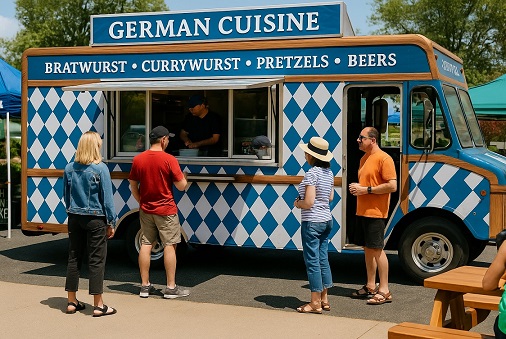
German cuisine might conjure images of beer halls, Oktoberfest tents, and cozy Alpine inns – but lately, it’s also appearing in parking lots, festivals, and curbside lunch rushes across the United States. Enter the German food truck: a growing phenomenon that blends street food culture with hearty European classics.
From bratwurst to schnitzel, spätzle to sauerkraut, mobile German kitchens are finding fans across America, offering authentic, often homemade flavors with a side of novelty. In places like Fayetteville, North Carolina, and Champaign, Illinois, local news outlets have recently spotlighted these trucks as they gain momentum in the crowded food-on-wheels scene.
So why are German food trucks booming now? What do they serve, and where can you find them? And most importantly – what makes them worth chasing down?
Let’s dig into the rise of German street food on American soil.
Related: Traditional German Food: A Culinary Tour Through the Regions
German Food Goes Mobile: A Growing Trend
The food truck revolution in the U.S. began in earnest around 2008, but for a while, German cuisine stayed under the radar. The fare didn’t seem as inherently “grab-and-go” as tacos or burgers. Yet in recent years, several factors have changed that:
- Growing interest in global flavors among younger consumers
- Oktoberfest popularity, creating demand for German food year-round
- Rising number of German-American heritage events seeking authentic vendors
- Flexibility of food trucks during and after the pandemic, when outdoor dining surged
Today, German food trucks are turning that interest into local success stories.
Fayetteville, NC: From Beer to Bratwurst
According to a 2025 feature in the Fayetteville Observer, a new German-themed food truck opened this spring, drawing crowds with classic wurst and warm pretzels. Run by a husband-and-wife team with ties to Bavaria, the truck parks at breweries, local events, and even private parties.
Popular menu items include:
- Bratwurst with sauerkraut and mustard on a crusty roll
- Käsespätzle – cheesy egg noodles topped with crispy onions
- Apple strudel – made fresh and served warm with vanilla sauce
Customer feedback highlights two main points: authentic taste and something different from the usual taco-pizza-burger trio.
Champaign, IL: “The German Food Truck” Turns Heads
In Illinois, Smile Politely recently reviewed “The German Food Truck,” which serves schnitzel sandwiches, currywurst, and rotating sides like cucumber salad and Bavarian potato soup.
Its popularity stems from a clear brand identity – the truck is designed to resemble a mobile beer hall – and high-quality homemade food. With a rotating menu and regular schedule near the University of Illinois, it caters to both locals and adventurous students.
Related: Bavarian Cuisine: Pretzels, Pork, and Beer Culture
Top Dishes You’ll Find on German Food Trucks
While offerings vary, most German food trucks stick to a few core items that balance portability, popularity, and preparation time:
- Bratwurst – grilled or pan-fried, usually served with sauerkraut, mustard, or curry ketchup
- Currywurst – sliced bratwurst with spicy tomato-curry sauce, often served with fries
- Schnitzel – breaded pork or chicken cutlets in sandwich form
- Spätzle – buttery or cheesy egg noodles
- German potato salad – warm, vinegar-based and bacon-rich
- Bavarian pretzels – large, salted, soft pretzels served with mustard or beer cheese
- Apfelstrudel – crisp, sweet, and packed with cinnamon apples
Optional specials include:
- Rouladen – beef rolls with mustard, pickles, and bacon (offered as weekend specials)
- Leberkäse – a baked meatloaf-style dish sliced and served hot on a roll
- Sauerkraut balls or kraut fritters
Drinks might include:
- Imported German sodas (Bionade, Spezi)
- Non-alcoholic malt beverages
- Warm mulled cider in colder months
What Makes German Food Truck Fare Appealing?
For American diners, German food trucks offer something satisfying and familiar – but still a little exotic. It’s comfort food with European flair. The appeal comes from several angles:
- Hearty, satisfying meals – meat, bread, cheese, potatoes
- Cultural authenticity – many owners have German roots or culinary training
- Festival and fair alignment – perfect match for local events and Oktoberfest-style gatherings
- Instagram-worthy aesthetic – big pretzels, steaming schnitzels, colorful trucks
Plus, there’s a growing population of German expats and German-Americans who crave a taste of home. Food trucks are answering that call.
How to Find a German Food Truck Near You
Google search trends reveal a rise in queries like:
- “German food truck near me”
- “Where is the schnitzel truck today?”
- “Bratwurst truck schedule”
These searches spike around:
- Oktoberfest (Sept-Oct)
- Christmas markets (Nov-Dec)
- University events and city fairs
To find one nearby:
- Use Instagram or Facebook – most trucks post daily locations
- Check local event pages – food trucks often list appearances
- Try apps like StreetFoodFinder or Roaming Hunger
- ** Search Google Maps for ‘German food truck’ + your city**
Related: Seasonal German Foods: From Asparagus to Christmas Goose
From Sausage Cart to Cultural Bridge
German food trucks are more than rolling kitchens – they’re ambassadors of culture. Some operators use them as platforms to teach customers about German traditions, holiday customs, or regional dishes.
Examples include:
- Seasonal menus based on real German food traditions (Spargelzeit, Grünkohlzeit, Martinstag)
- Trivia cards about German culture at the pick-up window
- Multilingual signage in both English and German
Customers often walk away not only fed, but curious – and that’s part of the magic.
The Bratwurst Revolution Has Wheels
From Fayetteville’s brat-slinging newcomers to Champaign’s schnitzel-on-wheels veterans, German food trucks are redefining how Americans experience Central European cuisine. It’s fast food – but with centuries of tradition baked in.
As demand for authentic, mobile, and hearty meals continues to grow, don’t be surprised if a German food truck rolls up at your next street fair, brewery patio, or lunch break.
Just follow the scent of sauerkraut.
Explore More German Cuisine:







